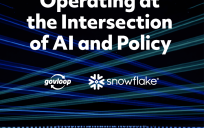This blog post is an excerpt from our recent report created in partnership with Genesys, The Potential of Artificial Intelligence in Government Citizen Engagement. To download the full report, head here.
Chatbots and AI are about reaching a point where people can dialogue with data. Agencies should start with identifying the most common self-service tasks that citizens need that can easily be automated – like directing users to a particular resource page, payment services or appointment scheduling. And while some organizations are familiar with chatbots, many may be averse to integrating them into agency operations due to a lack of understanding of the technology’s potential. A lack of knowledge of the technology, however, is not always the issue. For many, the integration of AI represents a major change in culture and operations that may not match with citizens’ current idea of government. For instance, many citizens and agencies alike are concerned with the idea of chatbots replacing human interaction.
But agencies should still begin to at least experiment with deployment of artificial intelligence – and no big steps have to necessarily be undertaken. With a trusted partner, small steps and concepts of artificial intelligence can be explored.
“Often, we will begin our engagement with organizations with an attempt to understand their current process, why efficiency is needed and where efficiency can be improved,” Minta said. “It’s all about the small steps.”
Here are five ways the public sector can start thinking about incorporating artificial intelligence, automation and chatbots.
- Consider reusability of automation technology. It’s important that agencies think beyond just a chatbot on a website, and consider a bot that can be built once, then made available across multiple channels – including web, mobile, messaging applications, and even voice IVR – for consistent self-service regardless of how a citizen reaches out.
- Accelerate the creation of bots using pre-built business processes or MicroApps. MicroApps are mini embeddable apps that provide a pre-defined modular set of capabilities to accomplish a specific task. They make it much easier to deploy AI across all channels, consistently and quickly, and allow for rapid deployment of the most common self-service tasks (such as address changes, bill payments and password resets). Genesys offers 80-plus pre-built and proven MicroApps that can be leveraged today.
- Ensure that any automation is part of your overall omnichannel strategy. Today’s citizen journeys happen on multiple communication channels, including email, web chat, social media and more. Creating and sustaining customer relationships across assisted and self-service channels is the key to an agency’s success. To build exceptional experiences, citizen engagement must be seamless, proactive and personalized across all channels and touchpoints throughout the entire lifecycle. If a chatbot is part of your strategy, remember that citizens may need to escalate to a live agent and expect to not have to repeat themselves, or agents may need to refer back to previous interactions that a citizen had with a bot, so it’s important that the chatbot and automation be part of the omnichannel experience.
- Take a blended approach to AI. AI alone cannot consistently deliver a great citizen experience. The power of AI reaches its fullest potential when it’s seamlessly combined with live agents — assisting your agents with more contextual information while giving your customers the personalized journey they expect. With blended AI, agencies can improve citizen service applications while making operations smarter and more cost-effective. AI solutions are excellent for handling simple requests, automated conversations or proper routing, while human agents are still excellent at understanding customer emotions, building trust and handling more complex requests.
- Try journey-mapping to learn where you could be implementing AI to enhance the citizen experience. How do you visualize a scenario to see the full picture of where AI could ease pain points that happen during citizens’ interactions with your agency? The short answer is by creating journey maps that visually document a citizen persona’s needs, perceptions and the touchpoints encountered for each step toward the citizen’s journey goal. Journey maps are a common approach used to design customer-centric processes for multi-channel engagement. They often serve as the foundation for customer experience optimization programs, identifying new ways to help your customers reach their goals while still delivering on the organization’s objectives. As you map the journey of a citizen engaging with your agency, ask yourself: Where could chatbots or automation simplify things, both externally and internally?





Thanks for this article. Yes, basic awareness of AI is a much needed and the blended approach makes a lot of sense.